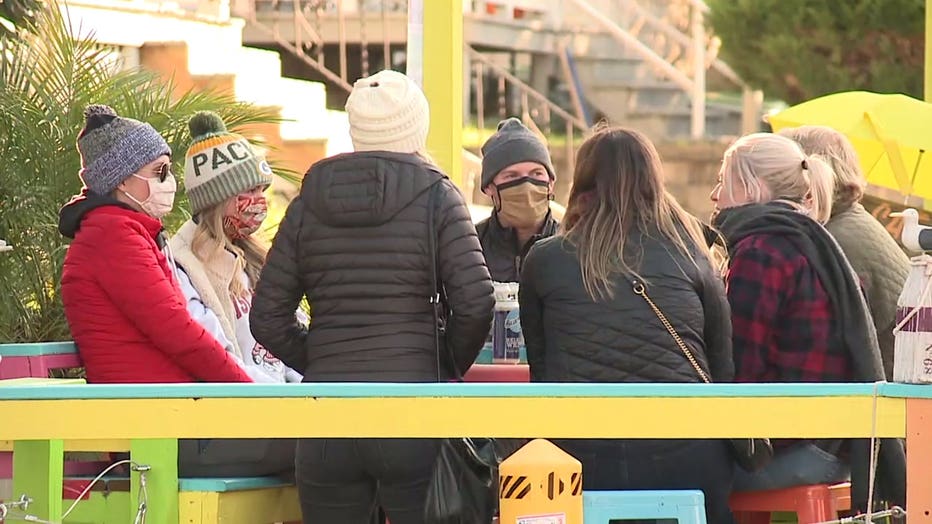Milwaukee committee passes new outdoor dining guidelines

Milwaukee committee passes new outdoor dining guidelines
New, proposed guidelines for Milwaukee's 'Active Streets' program, passed on Wednesday, lay the groundwork for what outdoor dining may look like in the months to come.
MILWAUKEE - The City of Milwaukee's Public Works Committee on Wednesday, Oct. 21 passed new, proposed guidelines for its Active Streets program, laying the groundwork for what outdoor dining may look like in the months to come.
Midwesterners are a hardy bunch and, based on a survey by Milwaukee's Downtown Business District, more than two-thirds of those surveyed said they would dine outdoors in winter if heaters were available.
"It's extremely important that we don't try...to recreate indoor activity outside. So we don't want anything fully enclosed," said Milwaukee Alderwoman Marina Dimitrijevic.
Forty-two businesses in the city have used the Active Streets program through the summer but, as fall turns to winter, snowy weather isn't far off.

Outdoor dining at Odd Duck in Bay View
"For us, any little bit helps," said Melissa Buchholz, owner of Odd Duck in Bay View.
The proposal would allow businesses to put up city-approved temporary structures with no more than 50% enclosed to allow for airflow. Electric heater would also be allowed.

Outdoor dining in Milwaukee
Milwaukee Alderman Mark Borkowski, though, raised concerns about "winterizing" costs.
"It's great that we're making this as an opportunity," said Borkowski. "These costs have to be given back to the consumer, and we just need to be cautious about that."
Dimitrijevic, the author of both Active Streets and the proposal, said that as the COVID-19 pandemic continues, it is forcing the city to change how things are done.
"We never thought that we'd be here at this time and unfortunately we are," Dimitrijevic said. "In fact, I'm a firm believer that by us grasping onto what was once normal, it's actually preventing us from getting back to anything remotely close to normal."
FREE DOWNLOAD: Get breaking news alerts in the FOX6 News app for iOS or Android
The proposal looks to continue the streamlining of applying for and granting outdoor dining permits.
The plans must still be approved by the full Milwaukee Common Council.
Guidelines for the fall and winter Active Streets program can be found online here.
Fall and winter Active Streets guidelines
Structures Temporary outdoor structures, including tents, are allowed in the public right of way under the following regulations:
- Temporary outdoor structures must have at least 50% of the total wall space open to allow airflow.
- Enclosed structures, such as plastic domes, may be used for individual parties and must have adequate ventilation to allow for air circulation.
- Temporary structures must be weighted, anchored or secured to the ground, but cannot be anchored with any method that requires screwing, cutting or drilling into the public way (i.e. streets or sidewalks).
- All structural materials should have fire-resistant certification or flame certification showing material is fire-rated or noncombustible.
- The use of tents and other temporary structures may be deemed unsafe and prohibited during severe weather events (wind, snow, etc.).
Heating Devices Heating Devices are allowed but must meet the following operational regulations:
- Heating equipment must be shown on the site plans submitted with the permit application.
- Electrically-powered heating devices are permitted; they must be installed by a licensed electrical contractor, who will obtain an electrical permit. Electrical heating equipment must be marked “UL listed” or “UL classified”
- Natural gas heaters or any devices fueled with propane are only allowed in open, uncovered sidewalk areas. No propane devices will be allowed in the roadway.
- Applicants should follow any recommended safety guidelines issued with a specific product (see the product’s operations manual)
- Heating equipment should be unplugged or disconnected or overnight storage, and employees should be trained in the proper installation of fuel tanks and in detecting leaks.
- The establishment should maintain clearance between heaters and all other objects, including tent sides. Required minimum clearance distance depends on the heating device; three feet is recommended.
- Cords or materials to power or fuel heating elements should create tripping hazards or violate ADA guidelines.
- Patrons must not interact with the heater.
Safety Considerations: Follow these additional safety considerations to ensure responsible operations:
- Outdoor spaces with heating devices must keep devices away from combustible materials, such as tents, at all times.
- Enclosed areas with heating devices must have clearly marked entrances and exits.
- Businesses must have sufficient fire extinguishers to cover indoor and outdoor spaces.
- Restaurants/Bars will need inclement weather plans in writing and trained staff to prevent injuries in storms, snow or other unsafe situations.
Related
Milwaukee restaurants adjust as colder temps arrive
The decision to reopen dining rooms, though, isn't always an easy one. Taking your food to-go, or dining outdoors, have been the popular options since the pandemic began.
Related
Shopping, dining out persist amid Wisconsin's COVID-19 surge
People who spoke with FOX6 News on Friday said they still feel comfortable going shopping and stopping in for food, despite the case surge.



